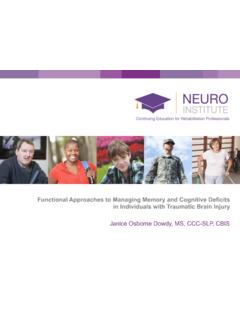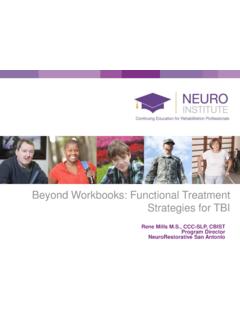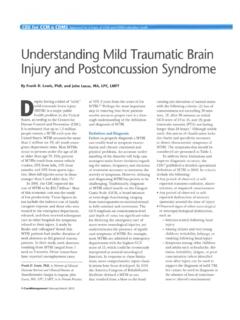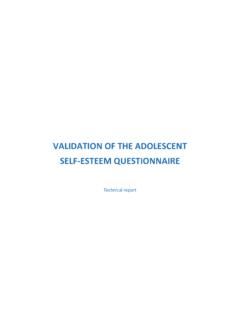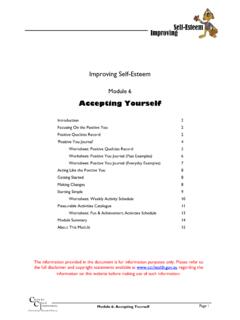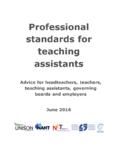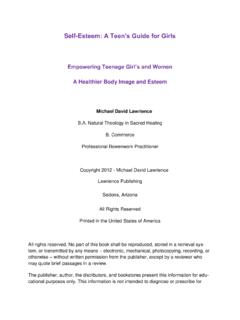Transcription of Improving Insight and Awareness in Brain Injury
1 Kristy Easley, , CCC-SLP, CBIS NeuroRestorativeImproving Insight and Awareness in Brain InjuryLearning Objectives Relate the anatomy and physiology of the pre-frontal cortex and frontal lobes to the clinical phenomenon of anosognosia. Identify and contrast two different models of Awareness to support treatment planning. Describe at least 2 effective strategies to improve Insight and Awareness in Brain Function & InsightLobes of the Brain Frontal lobes comprise 20% of cortex Function as CEO of the brainMetacognition- Thinking about thinking Anosognosia A deficit of self - Awareness Also known as a lack of Insight Refers to a condition in which a patient is unaware of deficits resulting from a Brain injuryAnosognosia I m ok to drive. Ninety percent of driving occurs straight in front of RS, a 60 y/o with severe left neglect and left homonymous hemianopsia. Your mailboxes are not set up like USPS. Had the names been to the right side, I would have scored 100%.
2 DH, 58 y/o rural mail carrier with severe left neglect after finding out his score on a mail delivery task was 56% - Awareness deficits in Brain Injury have been reported as occurring in up to 97% of patients with Traumatic Brain M, et al, 1998 What s in YOUR tool belt?Treatment for Awareness DeficitsIntellectualEmergentAnticipatory KnowledgeOnline awarenessCrosson, et al, 1989 Togliaand Kirk, 2000 Model of Awareness Anticipatory Awareness : Patient is able to anticipate when an impairment will affect performance and implement strategies. Emergent Awareness : Patient recognizes when an impairment affects their ability as it occurs. Intellectual Awareness : Patient may be aware a problem has occurred, but is unable to identify , et al., 1989 Dynamic Comprehensive Model of Awareness -Togliaand Kirk 2000 Dynamic instead of hierarchic relationship Knowledge beliefs, task demands, and context of situation Distinction between knowledge and online Awareness self knowledge-understanding of one s strengths and limitations Online Awareness -metacognitive skills applied in the context of an activityToglia and Kirk, 2000 Models of AwarenessANTICIPATORYEMERGENTINTELLECTUA L( self -Knowledge)
3 OnlineAwarenessIntellectual Awareness Deficits Trouble with understanding at the lowest level that difficulties exist with performing a particular activity Likely also have challenges with abstract reasoning and memory Not able to generalize knowledge from one situation to another AKA Deficits in self -Knowledge Training Intellectual Awareness Concrete language Education about personal Brain Injury Strengths and Weaknesses Lists Cued external compensatory strategies High rate of repetitionsExternal Compensatory Tools Journals Videotape review Social Stories Alarms Written daily schedule Sticky notes Significant deficits in memory provide the most significant barrier to developing Intellectual Awareness / self -Knowledge May always require external cues from caregiver Training Caregivers is Very ImportantEmergent Awareness Deficits Difficulty recognizing a problem while it is actually happening Trouble monitoring the connection between actions and environment Deficits at this level are the MOST FRUSTRATING to caregivers and cliniciansAnticipatory Awareness Deficits Unable to realize in advance that a particular deficit might cause a problem in the future Cannot predict that a learned compensatory strategy could help AVOID a problemOn-line Awareness Deficits Term used to refer to the concepts of deficits in emergent and/or anticipatory Awareness Idea that Awareness deficits are task and context dependentTraining Techniques Corrective Feedback Compensatory Strategy Selection and Training Rating ScalesPATIENT COMPETENCY RATING SCALE(PCRS)Prigatano, 1986 Features of the PCRS 3 available versions Patient Family Member Clinician Utilizes 30 questions Rank from 1-5 Max Score 150 Easy to print and utilize Free on COMBI Oreo self -Evaluation Before task: How difficult will this be?
4 Will I need to use any strategies?What strategies should I use?What problems might come up? After task:How difficult was this for me?How accurate was I?How much help did I need?What could I do differently next time?Clinical Activities Videotape review Role play with other patients in a group Peer Counseling Cognitive obstacle course Community-based activitiesCOGNITIVE OBSTACLE COURSE Set -up A Pill/Medicine Box Respond To Email Alphabetical Filing Timed Testing Pack A Lunch Box Write A Note To A Teacher Or Friend Mailbox Sort Navigating Automated Answering Service Pay A Telephone Bill Pack Given A ScenarioCOGNITIVE OBSTACLE COURSET eachable MomentsProvide opportunities for self - discovery of errors. Additional Components of Training Set appropriate goals WITHthe client Reduce strategies and control as increased safety and Awareness is observed Educate family, friends and other caregiversIncreasing Awareness can lead to lower self - esteem and increased incidence of & Coetzer, 2011 The fruits of our labor may be harvested after patients leave our Study Zach, 35 year old TBI in April 2016 due to motocross accident GCS of 11 in ER with positive loss of consciousness at scene Numerous fractures to scapula, ribs, clavical, and both arms Hospital course complicated by confusion, agitation and increased pain Required skilled therapy during post-acute rehab to facilitate increased self - Awareness of related cognitive and emotional changesKEY POINTS self - Awareness deficits affect almost all survivors of Brain Injury .
5 self - Awareness is a complex skill of cognition (METACOGNITION). There are many different strategies to use during rehab. Improvements in self - Awareness take , E., & Coetzer, R. (2011). Identity, grief and self - Awareness aftertraumatic Brain Injury . Neuropsychological Rehabilitation, 21(3), 289-305. CrossonB, Barco PP, VelozoCA, BolestaMM, Cooper PV, Werts D, BrobeckTC. (1989). Awareness and compensation in postacutehead Injury rehabilitation. Journal of Head Trauma Rehabilitation, 4, J. (2010). self - Awareness . In: JH Stone, M Blouin , editors. InternationalEncyclopedia of Rehabilitation. Available online: J, OwnsworthT. (2006). A review of Awareness interventions in Brain Injury rehabilitation. Neuropsychological Rehabilitation, 16, 474-500. PrigatanoGP, KlonoffPS. (1998). A clinician s rating scale for evaluating impaired self - Awareness and denial of disability after Brain Injury . The Clinical Neuropsychologist,12, , SchacterDL. (1994).
6 Awareness of deficit after Brain Injury : Clinical andtheoretical Issues. Clinical NeuroPhysiology, 91 (4), , Oden K, BergloffP, Levin E, High WM Jr. (1998). Assessment and treatmentof impaired Awareness after Brain Injury : implications forcommunityre-integration. NeuroRehabilitation, 10(1), , J. & Kirk, U. (2000). Understanding Awareness deficits following Brain Injury . NeuroRehabilitation, 15, 57-70. Toglia , J. P. (1991). Generalization of treatment: A multicontextapproach to cognitiveperceptual impairment in adults with Brain Injury . American Journal of Occupational Therapy, 45, 505-516.
